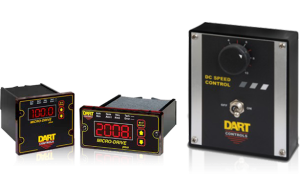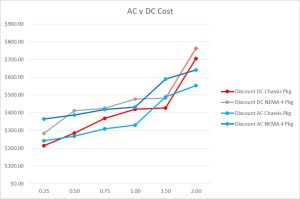
Variable speed motor controls (‘drives’) have been around for many decades. In the early years, application and budget were the primary decision criteria for choosing between a DC motor/drive package and AC equivalent. While this practice continues, the advances in AC drive technology have made the decision more complex to where either AC or DC meet application requirements. The decision criteria are broader and now include:
- Application Requirements
- Ease of Installation and Operation
- Cost and Availability
- Maintenance and Support
- The Impact of Brushless DC
A quick review of published information on this subject yields a preponderance of articles that lean toward AC being the better choice, especially with the advent of lower cost, more capable AC variable frequency drives (VFD’s) – drives that produce from an induction motor the kind of speed/torque response previously found only with DC permanent magnet motors. But these same articles concentrate on larger motors – the majority of drives and motors sold in terms of annual units are fractional to 2HP size motors.
This article will focus on AC vs. DC drive selection for speed and simple direction control of motors 2HP and smaller.
Application Requirements
Requirements of the specific application will factor into the AC vs. DC decision. Does the application require high starting torque from the motor? Examples might include centrifugal loads like turntables or wheels on a pitching machine; or pumping viscous fluid. This used to be an easy DC choice. However even the most basic AC drives now have ‘boost’ as a feature, which will produce additional torque at lower motor speeds. And, for a few dollars more one can use an AC Vector drive which also produces more motor torque at low speeds.
Supply voltage to the drive/motor package is also a consideration. The least expensive AC VFD uses 3- phase AC supply voltage – this simplifies the power supply front-end of the drive circuit. However, as an OEM equipment design engineer you cannot always rely on 3-phase power being available to your customer. Single phase supply voltage is more commonly available domestically as well as internationally – but the VFD power supply circuit is more involved for 230VAC single phase supply and even more so for 115VAC, which adds cost.
With DC drives 2HP and smaller supply voltage is of minimal concern – most drives today are designed to handle 115VAC or 230VAC (single phase) supply voltages using the same circuit design.
For applications that require the drive to be mounted where it is subjected to moisture – rain or direct wash down – NEMA 4/4X (IP65/66) rated DC drives are readily available. Brand choices of wash-down AC drives are more limited, although several companies are said to be developing them.
For applications that require motor braking or reversing, AC drives have the advantage: the output voltage switching to accomplish motor braking and/or reversing many times use the same solid state devices (MOSFET’s/IGBT’s) used to control the motor speed. Basic DC drives typically employ mechanical relays to reverse motor armature voltage polarity and additional circuitry to brake the motor (using a power resistor) and confirm the motor has stopped before allowing armature voltage polarity switch – added complexity and cost. Regenerative DC drives use solid state technology to brake and reverse the motor much like an AC drive – with significant added cost due to circuit complexity.
Ease of Installation and Operation
DC drives have the advantage in this category – as few as four wires to connect, flip the switch and you are running. The same model drive can typically handle a range of motor sizes and voltages – setup is as simple as a few trim pot adjustments based on motor voltage and HP rating.
AC drives typically require some amount of parameter configuration, or ‘commissioning’ to install. Progress has been made to ease commissioning by use of factory default parameter settings and ‘quick start’ parameters settings. While simpler, any amount of parameter configuration to install a drive puts pressure on plant personnel and their relative level of expertise and training. For a significant number of customers, ease of installation is a primary factor when choosing their drives.
Cost and Availability
A general rule of thumb regarding total cost of motor and drive package, when comparing AC to DC, is:
- For AC, as motor HP increases the total cost is less compared to DC
- For DC, as motor HP decreases the total cost is less compared to AC
If we collect data and plot total cost vs. HP rating we have curves that should intersect at some (motor HP) point – let’s use some pricing examples to see where that might be.
To set this up, we will use real-world data. In other words, data indicative of the actual purchase price for one control and one motor as defined in the following. The other important clarification is the manufacturer’s List or Retail prices were identified but not used in the chart, since companies use different pricing and discount schedule methods. The reasonable comparison is the 1 piece net price that is readily available to anyone regardless of company size or annual purchases – this is plotted in the following graph.

From a pure cost perspective, it appears the cost/HP crossover point is somewhere around or just below 1/2HP. The cost choice is muddled from ½-2HP. The absence of a clear choice AC vs. DC seems to fit the reality in the market, and demonstrate other factors are more important when making the choice.
Another consideration involves product availability – literally, how easy is it to find the AC or DC drive and motor that meets the application requirements? At issue here is standard product (features) vs. modified or custom product. Standard product generally is less expensive and certainly more readily available from more sources. The previous Cost Analysis used all standard product for comparison.
It is possible that a specific feature (serial communication is a great example) which is a common standard feature for an AC drive is an expensive option for a DC drive. This may be the determining factor to use an AC drive/motor solution. Another issue is Customer Service: an OEM may find it advantageous to use a drive and motor that is readily available to their end user from a local distributor, should replacement be required. The other side of this issue: an important part of an OEM’s business plan may be revenue from service contracts, or the equipment is complex and having the customer perform drive system component replacement would cause more harm than good.
There are many examples of how availability of the drive/motor selected will impact BOM cost, quality, market image and equipment performance. No clear choice between AC and DC can be made on availability, however the case can be made it should be considered during the equipment design phase.
Maintenance and Support
The main operational factor with DC permanent magnet motors is the need for regular preventative maintenance. Carbon / carbon compound brushes require regular inspection and replacement. The duty cycle of motor operation must be considered when choosing between AC and DC – longer periods of expected motor use argue toward the choice of AC.
The main operational factor with AC VFD / induction motors is a phenomenon known as ‘shaft currents’. These are currents induced in AC motor internal components when used with a VFD. In motors 2HP and smaller, these currents are minimal but over time can result in shorter than expected motor bearing life. The solutions to the shaft current issue are expensive relative to the VFD and motor cost; they rarely if ever are employed in the HP range for which this discussion is focused. It is much less expensive to simply replace the motor when needed.
At the drive level, DC drives are generally easier to support. The education / experience level requirements of personnel who support drives in general are less for DC than AC. AC drive development continues to add complexity to ‘micro’ VFD’s (lower voltage/HP rated), creating more pressure on skill level of support personnel. Add to this the inclusion to VFD’s of Programmable Logic Controller (PLC) logic and I/O, and the capabilities of support personnel are further driven nearer to degreed engineer.
The Impact of Brushless DC
Brushless DC technology is a true hybrid of traditional AC and DC motor and drive technology. Because most DC brushless drives are used with motors <2HP, three-phase supply voltage is typically not needed. Beyond that, brushless DC seems to incorporate the best features of AC VFD and DC SCR technologies, albeit at a 20-30% total cost premium (see Cost and Availability section for definition of cost parameters used for Total Cost determination). In addition brushless DC technology offers higher RPM, quiet operation, energy efficiency and for some applications a smaller/lighter motor.
Conclusions
The comparisons offered and criteria for selection in this discussion are consistent with the reality of the small motor market – there is no clear-cut choice of which technology to use. It is application / organization driven. This would explain why even though the traditional DC market has contracted over the last 20 years, it remains viable and should continue so until some major technology or regulatory shift were to occur. Brushless DC technology is gaining ground as it includes some of the best features of both AC and DC traditional drive technology, at a lower price premium than in years past.
Mark Lewis is Vice President – Marketing and Sales for Dart Controls, Inc. Dart designs and produces SCR, Digital and BLDC drives for the OEM and user markets at its factory in Zionsville, Indiana USA. Dart will celebrate 50 Years of Speed Control Innovation in 2013. Go to https://www.dartcontrols.com/ to learn more.
